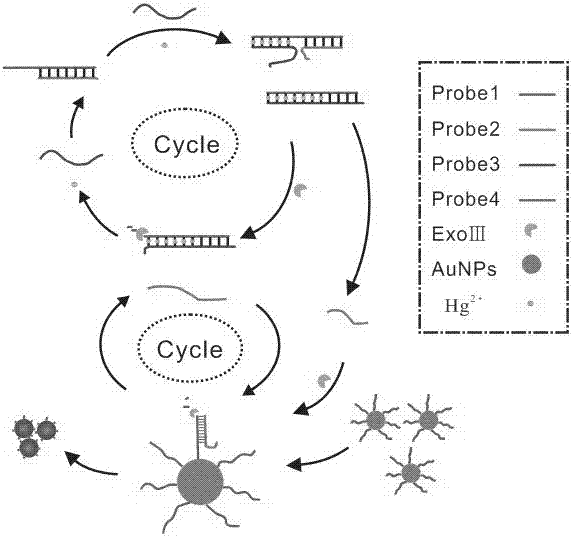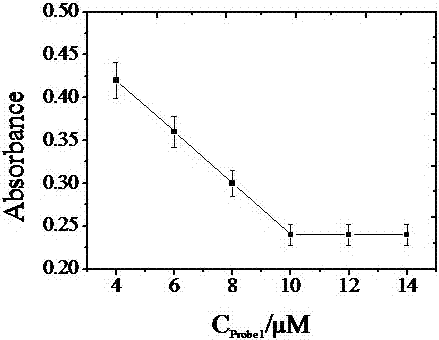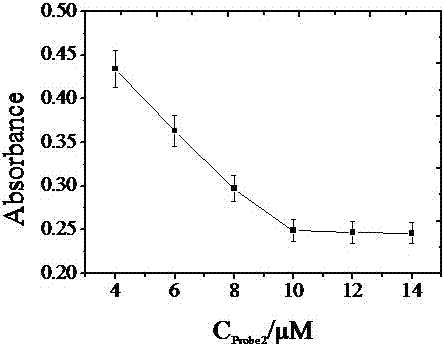Colorimetric biosensor for detecting mercury ions and preparation method thereof
A biosensor and mercury ion technology, applied in the field of biosensors, can solve the problems of low specificity and sensitivity, high cost, long detection cycle, etc., and achieve the effects of improved sensitivity, low detection limit and fast detection speed
- Summary
- Abstract
- Description
- Claims
- Application Information
AI Technical Summary
Problems solved by technology
Method used
Image
Examples
preparation example Construction
[0046] The preparation method of described biosensor comprises the following steps:
[0047] (1) Preparation of gold nanoparticles;
[0048] (2) Modify Probe4 to the surface of gold nanoparticles;
[0049] (3) Mix the labeled gold nanoparticles solution with the homogeneous reaction solution.
[0050]The preparation method, preferably the preparation steps of gold nanoparticles are as follows:
[0051] ① Install the required instruments and add 200ml of ultrapure water to the three-necked flask (be careful not to let dust fall into the three-necked flask);
[0052] ② Take 500uL (0.04g / ml) HAuCl 4 In a single packaged centrifuge tube, use a pipette gun to take 500ul and 200ml of ultrapure water, stir and heat at a stirring speed of about 450 rpm until boiling;
[0053] ③Under stirring conditions, take 3ml of 1% trisodium citrate solution and quickly add it into the solution. Within a few minutes, the color of the solution changes from light yellow to wine red. After continu...
Embodiment 1
[0064] The steps for modifying Probe4 to the surface of gold nanoparticles are as follows:
[0065] a. Take 1 mL nano-gold solution in a centrifuge tube, centrifuge for 10 min, and centrifuge the two tubes at the same time for later use. Centrifuge until the supernatant is colorless and transparent, remove the supernatant, and add 300 μL of sterile water to concentrate the nano-gold solution to 3 nM. Transfer to a 1 mL glass bottle and seal with tinfoil;
[0066] b. After standing at room temperature for 30 minutes, add 150 μL of -SH-modified substrate probe (Probe4) with a concentration of 30 μM, mix well, and place at 4 °C for 24 hours;
[0067] c. Slowly add 50 μL of PBS buffer several times, add magnets (soaked in aqua regia the day before) and stir for 10 min, then continue to add 27 μL of PBS buffer. Take out the magnet and place it at 4°C for 48 h;
[0068] d. Transfer the labeled gold nanoparticles solution to a centrifuge tube, add sterilized water to 1 mL, centrif...
Embodiment 2
[0078] The steps for modifying Probe4 to the surface of gold nanoparticles are as follows:
[0079] a. Take 1 mL nano-gold solution in a centrifuge tube, centrifuge for 10 min, and centrifuge the two tubes at the same time for later use. Centrifuge until the supernatant is colorless and transparent, remove the supernatant, and add 300 μL of sterile water to concentrate the nano-gold solution to 3 nM. Transfer to a 1 mL glass bottle and seal with tinfoil;
[0080] b. After standing at room temperature for 30 minutes, add 150 μL of -SH-modified substrate probe (Probe4) with a concentration of 30 μM, mix well, and place at 4 °C for 24 hours;
[0081] c. Slowly add 50 μL of PBS buffer several times, add magnets (soaked in aqua regia the day before) and stir for 10 min, then continue to add 27 μL of PBS buffer. Take out the magnet and place it at 4°C for 48 h;
[0082] d. Transfer the labeled gold nanoparticles solution to a centrifuge tube, add sterilized water to 1 mL, centrif...
PUM
 Login to View More
Login to View More Abstract
Description
Claims
Application Information
 Login to View More
Login to View More - R&D
- Intellectual Property
- Life Sciences
- Materials
- Tech Scout
- Unparalleled Data Quality
- Higher Quality Content
- 60% Fewer Hallucinations
Browse by: Latest US Patents, China's latest patents, Technical Efficacy Thesaurus, Application Domain, Technology Topic, Popular Technical Reports.
© 2025 PatSnap. All rights reserved.Legal|Privacy policy|Modern Slavery Act Transparency Statement|Sitemap|About US| Contact US: help@patsnap.com



